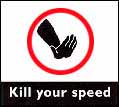
Ask
your self-a question, "How good a driver am I ?"
What makes you
so good ?, Well very often drivers have a perceived perception
of their skills based upon their own experiences and belief
in their abilities.
If you are travelling
103 ft per second at what speed are you driving? Need to look
up the answer.?
Do you know how
to read the speed of a bend accurately?
Do you know how
the police operate speed detection devices, or do you believe
that your alertness and observation will keep you one step ahead
of the game?.
Answer
to consider. "Each and every time you decide to speed or break
the rules of the road you will need to be lucky............
The
police only need to be lucky once......
Speeding is often
seen as a part of every day motoring and enforcement as an irritation
to driving. Drivers do not regard speeding as unlawful if the
limit is only broken by an acceptable margin. That margin is
very often set by the individual's conscience rather than by
any passed law or enforcement process.
"The vehicle is
designed to travel safely at much higher speeds"
"I know what I
am doing"
"It's the other
road users that are the problem"
Sound familiar.......?
These same drivers
often complain of the speed of vehicles in their own street
but are happy to do it in other streets It's all-right but not
in my back yard.
Speed enforcement
is often regarded as the enemy and something to be beaten. If
you cheat or defeat the system then all well and good, you are
hailed a hero. The accident is never going to happen to you
and if it does then it will be the fault of the other driver....
Won't it?
The fixed penalty
system along with all of the speed enforcement devices now used
are now seen as revenue collectors for the Government of the
day. It has become a game of chance and risk and so often justified
by the drivers who are caught. The idea is to avoid being detected
and if caught to avoid successful prosecution by whatever means.
There are many
devices now being employed to detect speeding motorists and
equally as many devices designed to confuse and make them obsolete.
Defences offered in court to undermine their credibility and
of those administering them. Publications have been produced
that detail how to avoid detection and prosecution.
Lets have a
look at the most common devices and how they are operated:
VASCAR.
The VASCAR device has
been in use for many years in the UK and represents the most
lenient form of enforcement to the motorist. It records the
average speed of a vehicle and this will display a lower speed
than the motorist was actually travelling.
The device measures
time over distance and this produces an average speed. The police
are trained over a prolonged period in order to determine their
margin of error. The margin of error is in fact a variance of
anticipation and not an error of reaction. This is often where
people assume that an officer can have an area of weakness during
its operation. It must be stressed that any error must be on
the anticipation of the operator and not on their reaction time.
Try it your self.
Set a stopwatch running and see how close to five seconds you
can stop the timer running. After a few attempts you will find
that you have anticipated the stop point very accurately and
this how it works. When a vehicle is observed approaching the
start of the check distance the operating officer can see both
the start of the check and the target vehicle and can easily
anticipate when the vehicle will strike the starting point.
The same happens at the end of the check. The margin of error
is very very small and often less than .03 mph.
It is the same
anticipation as a group of people clapping in time with one
another because they can anticipate when the next strike of
the hands occurs. It is the same as someone recording the lap
time of an athlete crossing the start and finish line: the timer
anticipates the moment when the runner passes the start finish
point and can record a very accurate time.
The VASCAR is
a very accurate means of determining the speed of a vehicle
and the motorist will have to prove that the operator did not
operate it correctly, a very difficult thing to do. It is very
unlikely that you will have a defence if caught with this device
because you will have to show that the operator did not act
in accordance with the guidelines. Most VASCAR check sites have
been approved and are the only static sites used especially
on Motorways where strict guidelines as to use are in force.
The following
check using VASCAR is even more difficult for the driver seeking
to avoid detection. The police drivers know exactly where to
sit to be in a driver's blind spot and so often they can be
very close to the target vehicle without the driver being aware.
This also holds good for the following check using the calibrated
speedometer.
VASCAR units in
police vehicles have to be calibrated on a regular basis and
from my experience they are, in fact most officers check the
device at the start and end of each working day and that is
well above the recommendations. If a case is contested the prosecution
is often dropped if the device has not been calibrated correctly
and in fairness officers generally do not use the device if
the calibration has not been carried out.
LASER.
This has become the preferred
means of enforcement for most police officers, it is portable
and very accurate and very easy to operate.
It projects a
pencil thin beam of laser light onto the target vehicle in the
area of the front registration plate. Providing it makes a clean
strike it will record the vehicle speed. By the time the average
motorists has seen the police vehicle the check has almost certainly
been completed and very often the officers are moving away before
you pass them.
Speed detection
devices in my experience do not work because by the time the
driver has reacted to the speed trap it is too late. And in
the case of VASCAR it does not work at all. If a driver travels
many many miles on the Motorways of this country he cannot sustain
the level of concentration that enables him to react in sufficient
time. It is human nature. He must also trust his luck that any
detection device will actually work and that he will be able
to react in time.
He will then,
if caught, rely on something in the procedure being wrong to
enable him to get away with the offence. If this is considered
then there are too many odds stacked against the speeding motorist.
The bottom line
is that if you decide to speed then the chances are that at
some point in time you will be caught. As a Motorway patrol
officer I often sit in full view of oncoming traffic and side
on to the direction of travel. The average motorist still travels
past in excess of 100 mph claiming not to have seen you. It
makes you wonder how these people would see and react to a real
emergency?
THE
UNMARKED POLICE VEHICLE.
This is the tool in the
police armoury that attracts most comment. "It's unfair, or
un-sporting of the police. It's sneaky or underhanded?"
The police use
the unmarked vehicle as a pure enforcement vehicle, often armed
with all of the speed detection equipment and Auto vision as
well. Its aim is to detect the more serious breaches of Road
traffic Law, the very high speeds or anti social behaviour demonstrated
by the minority of motorists. It removes the half-mile safety
bubble around the marked police vehicle. This is the area in
view of the police officers where everyone becomes the model
driver. The officers manning this vehicle see drivers in their
true light and target the worst offenders. To these officers
who witness and deal with the aftermath of many fatal accidents,
the carnage and long lasting images it is not a game, but a
deadly serious business.
With every road
death there is a grieving family and lost loved ones that leave
a legacy that lasts another lifetime.
In the late summer
of 1998 I had stopped a driver of a Subaru Impreza for driving
very fast along a country road in Oxfordshire, a "decent chap"
who suffered my words of wisdom. I was aware however that he
was not really listening to me. He had a racing background and
knew how to handle the car?
As I spoke to
him two cars travelling in opposing directions had a head on
collision directly in front of where we were standing. A closing
impact speed of 100-120 mph.
One of the drivers
lost an arm and another his sight permanently. He technically
died three times on route to hospital and will carry the legacy
of the high speed with him for the rest of his life.
The driver of
the Subaru? Well needless to say he opened his eyes and really
saw what happens when things go wrong. It is sad that the only
way to reach some people is for them to experience the reality
of a high-speed impact? I do not recommend it to anyone.
The next time you
leave home to get into your car take a long look back at what
you have and how precious it is to you.
Speed, or the love that a daughters smile carries?
Speed, or the love of a son so deeply cherished ?
The
Legacy.
"I broke the silence with
the faint opening of the ward door, the mother sat tearful and
empty at her daughters bedside. The broken shell of her daughter
lay distorted and twisted upon the covers. "She's only twenty
three and so full of life", but no longer.
Her companion
for the evening took a bend too fast and lost control and struck
a tree. He died instantly. The girl survived..... for what future.
The police officers, myself included, cried tears of hopelessness
at having witnessed the aftermath of yet another needless accident."
Drivers will speed
past the accident scene within a few hours and perhaps they
might notice the wilting flowers lain so carefully. A few miles
away the families of those involved live their own nightmare.......
but who cares because it is never going to happen to you.
Safe motoring
to each and every one of you, but remember if you break the
rules you must accept the consequences of YOUR actions and the
effects that it has upon other people. If you do not heed the
advice do not complain when the results of another's actions
affect you ?
A Serving Traffic
Patrol Officer
(Name and address supplied)
Two vehicles are
travelling along the Motorway, one in lane two and one in lane
three.
The vehicle in lane two is travelling at 70 mph
The vehicle in lane three is travelling at 100mph
At a given point the vehicles are alongside one another.
At this point they both have stop because of an obstruction ahead.
The vehicle in lane 2 skids from 70mph to a stop. At what speed
is the vehicle in lane three still travelling when the vehicle
in lane 2 is stationary ?
The vehicle in lane
three will still be travelling at 71mph???
100mph = 147ft per
sec. On impact it all ends in less than half a second?




